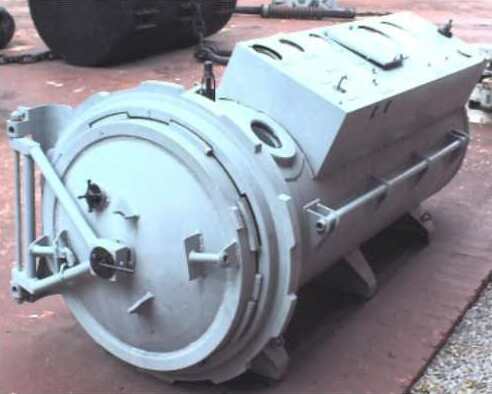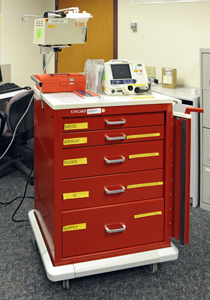|
Orinasal Mask
An orinasal mask, oro-nasal mask or oral-nasal mask is a Breathing mask (other), breathing mask that covers the mouth and the nose only. It may be a complete independent item, as an oxygen mask, or on some anaesthetic apparatuses, or it may be fitted as a component inside a fullface mask on underwater breathing apparatus, a gas mask or an industrial respirator to reduce the amount of Dead space (physiology)#In breathing apparatus), dead space. It may be designed for its lower edge to seal on the front of the lower jaw or to go under the chin. An orinasal mask may carry a air filter, filter for ambient air, or be supplied from a user-carried breathing gas supply or a remote gas supply using a supply hose. Another application is the resuscitation pocket mask, which is used as an infection barrier between the rescuer and a non-breathing casualty for expired air resuscitation. Applications Stand-alone orinasal units *Hyperbaric oxygen provision: The built-in breathing sys ... [...More Info...] [...Related Items...] OR: [Wikipedia] [Google] [Baidu] |
BIBS Mask Side View
BIBS may refer to: * A Built-in breathing system, Built-In Breathing System, a source of breathable gas for emergencies * The Bath_Building_Society, Bath Investment and Building Society, a British financial institution * The Beanstalk International Bilingual School system, based in Beijing, China {{disambiguation ... [...More Info...] [...Related Items...] OR: [Wikipedia] [Google] [Baidu] |
Built-in Breathing System
A built-in breathing system is a source of breathing gas installed in a confined space where an alternative to the ambient gas may be required for medical treatment, emergency use, or to minimise a hazard. They are found in diving chambers, hyperbaric treatment chambers, and submarines. The use in hyperbaric treatment chambers is usually to supply an oxygen rich treatment gas which if used as the chamber atmosphere, would constitute an unacceptable fire hazard. In this application the exhaust gas is vented outside of the chamber. In saturation diving chambers and surface decompression chamber the application is similar, but a further function is a supply of breathable gas in case of toxic contamination of the chamber atmosphere. This function does not require external venting, but the same equipment is typically used for supply of oxygen enriched gases, so they are generally vented to the exterior. In submarines the function is to supply a breathable gas in an emergency, which m ... [...More Info...] [...Related Items...] OR: [Wikipedia] [Google] [Baidu] |
Oxygen
Oxygen is the chemical element with the symbol O and atomic number 8. It is a member of the chalcogen group in the periodic table, a highly reactive nonmetal, and an oxidizing agent that readily forms oxides with most elements as well as with other compounds. Oxygen is Earth's most abundant element, and after hydrogen and helium, it is the third-most abundant element in the universe. At standard temperature and pressure, two atoms of the element bind to form dioxygen, a colorless and odorless diatomic gas with the formula . Diatomic oxygen gas currently constitutes 20.95% of the Earth's atmosphere, though this has changed considerably over long periods of time. Oxygen makes up almost half of the Earth's crust in the form of oxides.Atkins, P.; Jones, L.; Laverman, L. (2016).''Chemical Principles'', 7th edition. Freeman. Many major classes of organic molecules in living organisms contain oxygen atoms, such as proteins, nucleic acids, carbohydrates, and fats, as ... [...More Info...] [...Related Items...] OR: [Wikipedia] [Google] [Baidu] |
Crash Cart
A crash cart or code cart (crash trolley in UK medical jargon) or "MAX cart" is a set of trays/drawers/shelves on wheels used in hospitals for transportation and dispensing of emergency medication/equipment at site of medical/surgical emergency for life support protocols ( ACLS/ALS) to potentially save someone's life. The cart carries instruments for cardiopulmonary resuscitation and other medical supplies while also functioning as a support litter for the patient. The crash cart was originally designed and patented by ECRI Institute founder, Joel J. Nobel, M.D., while a surgical resident at Philadelphia's Pennsylvania Hospital in 1965. MAX helped enhance hospital's efficiency in emergencies by enabling doctors and nurses to save time, thereby increasing the chances of saving a life. The contents and organization of a crash cart vary from hospital to hospital, country to country, and specialty to specialty, but typically contain the tools and drugs needed to treat a person in ... [...More Info...] [...Related Items...] OR: [Wikipedia] [Google] [Baidu] |
Hospital
A hospital is a health care institution providing patient treatment with specialized health science and auxiliary healthcare staff and medical equipment. The best-known type of hospital is the general hospital, which typically has an emergency department to treat urgent health problems ranging from fire and accident victims to a sudden illness. A district hospital typically is the major health care facility in its region, with many beds for intensive care and additional beds for patients who need long-term care. Specialized hospitals include trauma centers, rehabilitation hospitals, children's hospitals, seniors' (geriatric) hospitals, and hospitals for dealing with specific medical needs such as psychiatric treatment (see psychiatric hospital) and certain disease categories. Specialized hospitals can help reduce health care costs compared to general hospitals. Hospitals are classified as general, specialty, or government depending on the sources of income received. A teachi ... [...More Info...] [...Related Items...] OR: [Wikipedia] [Google] [Baidu] |
Ambulance
An ambulance is a medically equipped vehicle which transports patients to treatment facilities, such as hospitals. Typically, out-of-hospital medical care is provided to the patient during the transport. Ambulances are used to respond to medical emergencies by emergency medical services (EMS). For this purpose, they are generally equipped with flashing emergency vehicle lighting, warning lights and siren (noisemaker), sirens. They can rapidly transport paramedics and other first responders to the scene, carry equipment for administering emergency medicine, emergency care and transport patients to hospital or other definitive care. Most ambulances use a design based on vans or pickup trucks. Others take the form of Motorcycle ambulance, motorcycles, buses, limousines, Air medical services, aircraft and Water ambulance, boats. Generally, vehicles count as an ambulance if they can transport patients. However, it varies by jurisdiction as to whether a Patient transport, non-emerge ... [...More Info...] [...Related Items...] OR: [Wikipedia] [Google] [Baidu] |
Resuscitation
Resuscitation is the process of correcting physiological disorders (such as lack of breathing or heartbeat) in an acutely ill patient. It is an important part of intensive care medicine, anesthesiology, trauma surgery and emergency medicine. Well known examples are cardiopulmonary resuscitation and mouth-to-mouth resuscitation Mouth-to-mouth resuscitation, a form of artificial ventilation, is the act of assisting or stimulating respiration in which a rescuer presses their mouth against that of the victim and blows air into the person's lungs. Artificial respiration ta .... Variables See also * * * * * * * * * * {{Shock Critical emergency medicine Emergency medicine Intensive care medicine ... [...More Info...] [...Related Items...] OR: [Wikipedia] [Google] [Baidu] |
Positive Pressure Ventilation
Modes of mechanical ventilation are one of the most important aspects of the usage of mechanical ventilation. The mode refers to the method of inspiratory support. In general, mode selection is based on clinician familiarity and institutional preferences, since there is a paucity of evidence indicating that the mode affects clinical outcome. The most frequently used forms of volume-limited mechanical ventilation are intermittent mandatory ventilation (IMV) and continuous mandatory ventilation (CMV). There have been substantial changes in the nomenclature of mechanical ventilation over the years, but more recently it has become standardized by many respirology and pulmonology groups. Writing a mode is most proper in all capital letters with a dash between the control variable and the strategy (i.e. PC-IMV, or VC-MMV etc.). Taxonomy for mechanical ventilation The taxonomy is a logical classification system based on 10 maxims of ventilator design 10 maxims #A breath is one cyc ... [...More Info...] [...Related Items...] OR: [Wikipedia] [Google] [Baidu] |
Bag Valve Mask
A bag valve mask (BVM), sometimes known by the proprietary name Ambu bag or generically as a manual resuscitator or "self-inflating bag", is a hand-held device commonly used to provide positive pressure ventilation to patients who are not breathing or not breathing adequately. The device is a required part of resuscitation kits for trained professionals in out-of-hospital settings (such as ambulance crews) and is also frequently used in hospitals as part of standard equipment found on a crash cart, in emergency rooms or other critical care settings. Underscoring the frequency and prominence of BVM use in the United States, the American Heart Association (AHA) Guidelines for Cardiopulmonary Resuscitation and Emergency Cardiac Care recommend that "all healthcare providers should be familiar with the use of the bag-mask device." Manual resuscitators are also used within the hospital for temporary ventilation of patients dependent on mechanical ventilators when the mechanical ventilator ... [...More Info...] [...Related Items...] OR: [Wikipedia] [Google] [Baidu] |
Anaesthetic Machine
An anaesthetic machine (British English) or anesthesia machine (American English) is a medical device used to generate and mix a fresh gas flow of medical gases and inhalational anaesthetic agents for the purpose of inducing and maintaining anaesthesia. The machine is commonly used together with a mechanical ventilator, breathing system, suction equipment, and patient monitoring devices; strictly speaking, the term "anaesthetic machine" refers only to the component which generates the gas flow, but modern machines usually integrate all these devices into one combined freestanding unit, which is colloquially referred to as the "anaesthetic machine" for the sake of simplicity. In the developed world, the most frequent type in use is the continuous-flow anaesthetic machine or "Boyle's machine", which is designed to provide an accurate supply of medical gases mixed with an accurate concentration of anaesthetic vapour, and to deliver this continuously to the patient at a safe pre ... [...More Info...] [...Related Items...] OR: [Wikipedia] [Google] [Baidu] |
Dust Mask
A dust mask is a flexible paper pad held over the nose and mouth by elastic or rubber straps for personal comfort against non-toxic nuisance dusts. They are not intended to provide protection from toxic airborne hazards. The European FFP1 mask, the lowest-grade mechanical filter respirator available in the jurisdiction, is also used as a dust mask. Dust masks are used in environments with dusts encountered during construction or cleaning activities, such as dusts from drywall, brick, wood, fiberglass, silica (from ceramic or glass production), or sweeping. A dust mask can also be worn in environments with allergens such as tree and grass pollen. A dust mask is also used to prevent the wearer from inhaling dust or sand in a dust storm. Description A dust mask is worn in the same fashion as a filtering facepiece respirator or surgical mask, but it is dangerous to confuse them because they each protect against specific airborne dangers. Using the wrong mask for a job can pr ... [...More Info...] [...Related Items...] OR: [Wikipedia] [Google] [Baidu] |
Diving Regulator
A diving regulator is a pressure regulator that controls the pressure of breathing gas for diving. The most commonly recognised application is to reduce pressurized breathing gas to ambient pressure and deliver it to the diver, but there are also other types of gas pressure regulator used for diving applications. The gas may be air or one of a variety of specially blended breathing gases. The gas may be supplied from a scuba cylinder carried by the diver or via a hose from a compressor or high-pressure storage cylinders at the surface in surface-supplied diving. A gas pressure regulator has one or more valves in series which reduce pressure from the source, and use the downstream pressure as feedback to control the delivered pressure, or the upstream pressure as feedback to prevent excessive flow rates, lowering the pressure at each stage. The terms "regulator" and "demand valve" are often used interchangeably, but a demand valve is the final stage pressure-reduction regulator ... [...More Info...] [...Related Items...] OR: [Wikipedia] [Google] [Baidu] |









